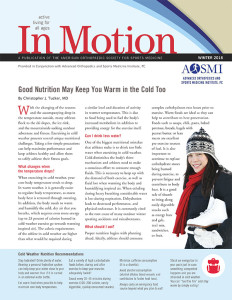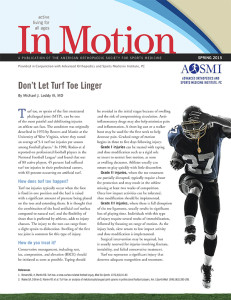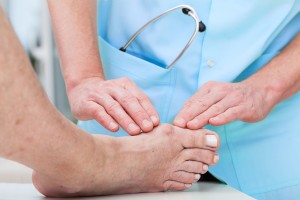 With the changing of the seasons and the accompanying drop in the temperature outside, many athletes flock to the ski slopes, the ice rink, and the mountainside seeking outdoor adventure and fitness. Exercising in cold weather presents several unique nutritional challenges. Taking a few simple precautions can help maximize performance and keep athletes healthy and allow them to safely achieve their fitness goals
With the changing of the seasons and the accompanying drop in the temperature outside, many athletes flock to the ski slopes, the ice rink, and the mountainside seeking outdoor adventure and fitness. Exercising in cold weather presents several unique nutritional challenges. Taking a few simple precautions can help maximize performance and keep athletes healthy and allow them to safely achieve their fitness goals
There’s a lot to love about sandal season. Visible bunions? Not so much. The silver lining is that this may be the wake up call some need to address a potentially serious problem.
What is a bunion?
A bunion occurs when the big toe begins to grow inward toward the second toe, pushing the joint of the big toe out. The joint can become red, swollen, and painful.
Bunions could be caused from a variety of reasons. They are significantly more common in women, and may be caused by rheumatoid arthritis and osteoarthritis, improper formation of bones at birth, or even trauma. Tight fitting shoes may exacerbate or even cause the problem.
First steps
If you suspect a bunion is forming, avoid wearing tight, narrow-toed shoes, which can worsen the condition. Wide-toed shoes and spacers, which are available at most major drugstores, may also help.
These steps can help alleviate pain, which may be fine for mild bunions. They are not necessarily corrective, however.
When to See a Professional
If a bunion is continuing to cause pain even after using toe spaces and switching to wide toed shoes, you should see a professional to discuss surgical options. You should also see a professional if there is any break in the skin to avoid infections.
Bunionectomy
Surgery to correct bunions is commonly know as bunionectomy. While it can be very successful at restoring mobility, it is important to follow up with lots of rest, proper footwear, and to expect a minimum three month period of recovery, during which time you may need to use crutches.
 The foot and ankle are an extremely complex structure that allows us to adapt to the forces of the ground and propels us forward. The bones, joints, muscles, ligaments and tendons work intricately together to allow for shock absorption and motion. Unfortunately, such a finely tuned system ends up overused, causing foot and ankle pain. The most common condition affecting this area is a sprained ankle.
The foot and ankle are an extremely complex structure that allows us to adapt to the forces of the ground and propels us forward. The bones, joints, muscles, ligaments and tendons work intricately together to allow for shock absorption and motion. Unfortunately, such a finely tuned system ends up overused, causing foot and ankle pain. The most common condition affecting this area is a sprained ankle.
What is a sprained ankle?
A sprained ankle occurs after an injury where the foot rolls under the ankle or leg. This stretches one or more ligaments causing pain and possibly bruising or swelling. Usually this happens while playing a sport, such as basketball where an athlete can come down from a jump and turn their ankle or land on an opponent’s foot.
There are two common types of sprained ankles:
– Inversion sprain: the ankle rolls inward, causing pain along the outer side of the ankle
– Eversion sprain: the ankle rolls too far inwards and is often accompanied by a fracture of the fibula bone.
To determine if it is just a sprained ankle or if there are other issues, the physician will need to get an x-ray of the area. Minor ankle sprains can be treated with rest, ice, compression and elevation. Severe ankle sprains may require a short leg cast or walking book for two to three weeks. Most ankle sprains do not require surgery but patients who have repeatedly sprained their ankles may need surgical repair to tighten the ligaments.
How does one recover from a sprained ankle?
Each ligament injury need rehabilitation and by completing this process, you will make yourself less likely to hurt the same ankle again. The recovery stages for an ankle sprain typically include:
– Resting the injured area
– Restoring flexibility, typically done through a physical therapy program
– Gradual return to full activity
Ankle sprains should be reviewed by a physician to rule out additional injuries, such as a fracture, but if you have pain along the inner side of the ankle, be sure to get evaluated by a doctor as this could be a more serious injury to the tendons and ligaments that support the arch of your foot.
If you have ankle pain or think you may have sprained your ankle, reach out to the specialists at Advanced Orthopedics and Sports Medicine institute for your consultation – call 732-720-2555 today!
 Turf toe, or sprain of the first metatarsal phalangeal joint (MTP), can be one of the most painful and debilitating injuries an athlete can face. The condition was originally described in 1976 by Bowers and Martin at the University of West Virginia, where they noted an average of 5.4 turf toe injuries per season among football players. 1 In 1990, Rodeo et al reported on professional football players in the National Football League2 and found that out of 80 active players, 45 percent had suffered turf toe injuries in their professional careers, with 83 percent occurring on artificial turf
Turf toe, or sprain of the first metatarsal phalangeal joint (MTP), can be one of the most painful and debilitating injuries an athlete can face. The condition was originally described in 1976 by Bowers and Martin at the University of West Virginia, where they noted an average of 5.4 turf toe injuries per season among football players. 1 In 1990, Rodeo et al reported on professional football players in the National Football League2 and found that out of 80 active players, 45 percent had suffered turf toe injuries in their professional careers, with 83 percent occurring on artificial turf
READ MORE
 Advanced Orthopedics and Sports Medicine Institute (AOSMI) is committed to bringing together the top talent from all of orthopedics, across a wide variety of specialty fields. The practice’s team includes experts in every type of orthopedic care, from pain management and wellness to joint replacement surgery, sports medicine, and physical therapy. AOSMI’s foremost specialist in foot and ankle surgery, Dr. Alison DeWaters, DPM, has performed exemplary work for the community and helped many patients reclaim their mobility and get back to the athletic pursuits and active lifestyles they cherish. Dr. DeWaters’ grateful patients have shared their positive experiences through many types of testimonials, including on sites that aggregate doctor reviews. At one such site, Healthgrades, Dr. DeWaters has the distinction of a perfect 5-star score across multiple patient reviews.
Advanced Orthopedics and Sports Medicine Institute (AOSMI) is committed to bringing together the top talent from all of orthopedics, across a wide variety of specialty fields. The practice’s team includes experts in every type of orthopedic care, from pain management and wellness to joint replacement surgery, sports medicine, and physical therapy. AOSMI’s foremost specialist in foot and ankle surgery, Dr. Alison DeWaters, DPM, has performed exemplary work for the community and helped many patients reclaim their mobility and get back to the athletic pursuits and active lifestyles they cherish. Dr. DeWaters’ grateful patients have shared their positive experiences through many types of testimonials, including on sites that aggregate doctor reviews. At one such site, Healthgrades, Dr. DeWaters has the distinction of a perfect 5-star score across multiple patient reviews.
Dr. DeWaters is one of the two AOSMI professionals with a 5-star Healthgrades rating; the other is Dr. Alan Nasar. Every member of the team has a rating of 4 stars or better in addition to these standout grades. AOSMI is honored to receive such acclaim from the community and dedicated to not only maintaining, but improving the high standards of quality care throughout the practice. The institute congratulates Dr. DeWaters on this achievement and encourages anyone looking to learn more to visit https://advancedorthosports.com/about-us/about-us/professionals/alison-dewaters-dpm/








